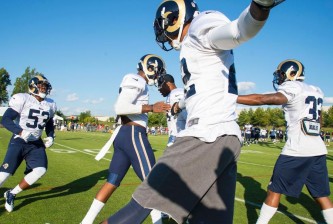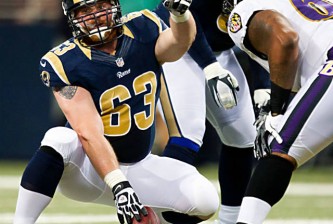
With no established receivers on the roster, the Rams seemingly can’t avoid being written into speculative internet headlines with every semi-available name-brand WR out there. Even one who is 34 years old and just spent the last two years in prison. So pardon us if we’re getting a little weary of it.
A quick summary of why the Rams and Burress continue to be linked by every media outlet out there: (a) he has more career touchdown catches than all the other Rams combined; (b) Coach Spagnuolo may have fond memories from their days together in New York.
But for every mass-media story on Burress, there is a rebuttal from a Rams columnist.
A quick summary of our points of contention: (a) he’s 34 years old; (b) he spent the last two seasons in prison after shooting himself in the leg.
Additionally, Burress’ skillset is pretty much limited to lining up as the X receiver — the same spot occupied by Danario Alexaner, Donnie Avery, and potentially Mark Clayton, all players the Rams have reasonable hopes for in 2011. He isn’t going to magically transform into a possession receiver, and even if he did the Rams have plenty of those already.
However, Burress’ pedigree as a first round pick, and the phenomenal comeback by the Eagles’ Michael Vick from his own prison sentence, give us two reasons to look deeper. Playing Devil’s Advocate, I did just that and found a Hall-of-Fame comparable that opened my eyes.
Using Pro-Football-Reference’s database, I looked up the list of modern-day receivers who were selected in the first round, and were productive at age 34 and beyond. The list is a pretty short one:
| Player | From | To | G | Rec | Yds | TD |
|---|---|---|---|---|---|---|
|
1996 |
2001 |
82 |
422 |
5263 |
39 |
|
|
1996 |
2000 |
78 |
289 |
3869 |
26 |
|
|
2000 |
2004 |
79 |
324 |
3990 |
25 |
|
|
2005 |
2010 |
69 |
234 |
3736 |
23 |
|
|
2006 |
2008 |
36 |
175 |
2249 |
18 |
|
|
1990 |
1993 |
57 |
157 |
2753 |
18 |
|
|
1991 |
1995 |
67 |
210 |
2786 |
16 |
|
|
1981 |
1983 |
35 |
134 |
2173 |
9 |
|
|
1989 |
1990 |
26 |
51 |
850 |
8 |
|
|
1976 |
1977 |
26 |
56 |
864 |
8 |
|
|
1975 |
1977 |
26 |
67 |
902 |
6 |
|
|
1980 |
1981 |
31 |
53 |
920 |
5 |
|
|
2006 |
2006 |
16 |
70 |
815 |
4 |
|
|
1984 |
1984 |
16 |
12 |
135 |
0 |
|
|
2007 |
2008 |
11 |
13 |
101 |
0 |
|
|
2005 |
2005 |
13 |
21 |
288 |
0 |
|
|
2007 |
2007 |
16 |
32 |
342 |
0 |
Of these players, only one came back from an extended absence to reclaim early glory — Hall of Famer James Lofton, who started only two games of his age 33 season, his first with Buffalo. Digging deeper into Lofton’s story, there are some eerie parallels that might give more weight to the argument for signing Plex.

Early career: Premier physical specimen quickly becomes a star.
Lofton, like Burress, is a big-bodied receiver standing well over six feet tall. (Most of the receivers on this list are six foot or under; draw your own conclusions about the durability of various body types.)
And Lofton, like Burress, was a top-ten pick who became an instant big-play threat lining up as the X-receiver. Lofton’s career started with the Packers, and after nine seasons — six in the Pro Bowl — had skyrocked toward stardom.
Mid career: Embarassing trouble in a club leads to sudden release.
Burress went from the most recognized weapon on the New York Giants to becoming the most famous example of Mayor Bloomberg’s “get-tough” stance on handguns. After his arrest and conviction, the Giants officially severed ties.
Lofton’s ties to the famously loyal and insular Green Bay community were similarly strained to the breaking point after an embarassing incident in a club.
Things unraveled for Lofton in 1986 when he was charged with sexual assault after an incident in a Green Bay bar. At the time, the Packers were already reeling from publicity surrounding a sexual-assault charge against defensive back Mossy Cade. They suspended Lofton with one game left in the 1986 season.
— New York Times: The Decline and Return of James Lofton
Lofton was later acquitted of the charge, but by then, he had been traded to the Raiders for next to nothing: a third-round draft pick in 1987 and a conditional fourth-round pick in 1988.
Make or break point: Facing life after football at age 32
Spending two years in Oakland may not be quite like spending two years in prison, but the time wasn’t kind to Lofton. The Raiders released him, and suddenly few teams in the NFL felt like picking up the phone when he called.
“I was talking to a friend of mine recently,” Lofton said. “And he said: ‘A lot of people would have looked at your situation in 1989 and said your football career had been destroyed, because you’d been cut from the second team you’d been with. God has other plans for you. It might be in football. It might be in something else.’ We laughed about that.”
However, Lofton leaned on former coaching connections to find a friendly situation to stage a rebirth, landing as the most-feared vertical threat in Marv Levy and Ted Marchibroda’s innovative vertical-oriented “K-Gun” offense.
Success didn’t come right away — his first season with Buffalo was plagued by injuries, and he caught only 8 balls in 12 games. But his stats from his age 34 to age 36 seasons were as good as any in his career:
| Year | Age | G | Rec | Yd | TD |
|---|---|---|---|---|---|
| 1990 | 34 | 16 | 35 | 712 | 4 |
| 1991* | 35 | 15 | 57 | 1072 | 8 |
| 1992 | 36 | 16 | 51 | 786 | 6 |
Lofton paired with Andre Reed, one of the all-time great “hands” receivers, and Thurman Thomas’ dual-threat running and receiving game to transform the Bills from a good team into a perennial threat to win it all.
The Rams have already restocked the “hands” part of their receiving corps. If there is reason to hope that Plaxico Burress could give Sam Bradford a coverage-changing big play threat, and be more than a one-year stopgap, that hope is embodied in James Lofton’s story.






















